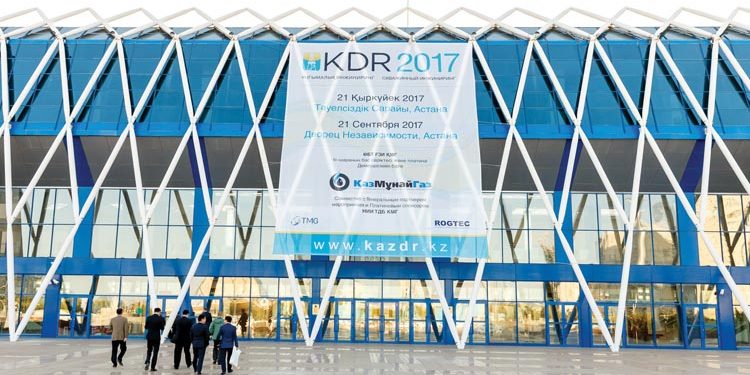KDR 2017 Event Review and Overview
21st September 2017
Palace of Independence, Astana
The 3rd KDR, Well Engineering Forum, the unique drilling and production conference held in direct partnership with JSC NC KazMunayGas and its Scientific Research Institute for Drilling and Production (SRI PDT), recently took place at the Palace of Independence in Astana on the 21st September. www.KazDR.kz
- Hosted in full partnership with KazMunayGas SRI-PDT (Scientific Research Institute for Drilling and Production Technologies)
- Largest yearly regional gathering of drilling and production heads and experts
The forum focused on on three key topic areas, focused on 3 key topic areas: Drilling, Completions and Well Stimulation. The event covered key regional topics in specific detail.
The day was divided into three technical discussion halls which were broken up with networking coffee breaks and a sit-down lunch. The KDR saw over 240 high level delegates from 120 participating companies. All the halls were filled with technical sessions, in-depth discussions and knowledge sharing.
After the event registration and pre-show coffee networking working period – all KDR participants gathered into Hall 1 for the events opening key note presentation:
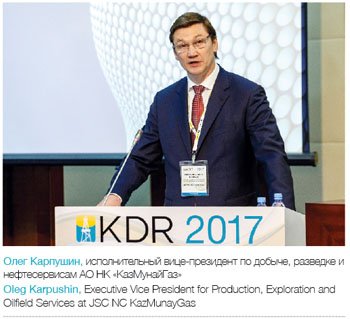
Oleg Karpushin, Executive Vice President for Production, Exploration and Oilfield Services at JSC NC KazMunayGas started proceedings, welcoming all participants and discussing his predecessor’s comments at KDR 2015 & 2016, by declaring his commitment that KMG “we will never drill uneconomical wells”.
It was intended to focus the attention of the KDR participants, the contractors and service companies, on improving drilling efficiency and optimizing drilling and production processes.
With the catchphrase of KDR 2015 being «We will not drill uneconomical wells», and moving on to «Improving drilling quality» in 2016 – Mr. Karpushin declared the KDR 2017 would focus on “improving the economics across the whole life cycle of the well”.
He went on to make it clear to all participants that, “Today we need to decide how to optimize the economics of life cycle of thousands of operating wells, what technologies can be used to improve economic efficiency for improving drilling, zonal isolation and well integrity, and decreasing annulus pressure. The aim of this forum is to exchange ideas and experience, also improve cooperation between customers and contractors. I hope to find effective cooperation and practical result of this event”.
With Mr. Karpushin finishing his keynote presentation, participants were then invited to join the three event discussion halls, and could choose between session halls: Drilling Services, Completions or Well Intervention.
Hall 1 (Drilling Services): Session 1
With Hall 1 dedicated to drilling and related services and strategies, some excellent discussions ensued. The sessions focused on key areas such as: Drilling Strategies, Well Placement, Horizontal Drilling, Drilling Fluids, and further discussion areas.
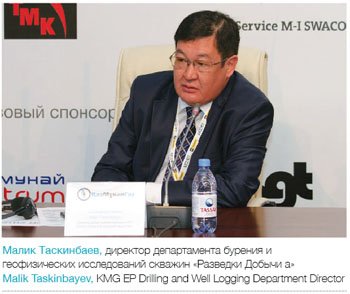
Moderating the first session was Malik Taskinbayev, KMG EP Drilling and Well Logging Department Director with the session speakers consisting of Amangeldi Makhambetov, Schlumberger Well Placement Domain Champion and Nuraly Guldzhumarov, Deputy Director of Drilling and Workover Department on «Supervising Activities at KMG EP».
Mr. Makhambetov, opened the session with his presentation titled «Well placement in a thin reservoir layer, a case study from Kazakhstan».
The presentation was a follow on from his KDR 2016 report about successful implementation of geologic navigation in complicated geologic conditions for JSC «CNPC-AMG» – and a year on, he discussed more examples of successful horizontal drilling.

It was a great opening presentation and initiated an in-depth Q&A, where session moderator Mr. Taskinbayev asked about the quality control of the geo-navigation and Assel Salimova, Head of Geological and Geophysical Department at Baker Hughes asked about, amongst other questions, whether real-time fracture permeability analysis was done to optimize well trajectory.
The second presentation of the session was delivered by Nuraly Guldzhumarov, KazMunayGas EP, Deputy Director of Drilling and Workover Department on «Supervising activities at KMG EP».
The presentation looked at the framework of creating a unified supervising system in which, KazMunayGas E&P is planning to launch a pilot project for implementing its own supervising service at the facilities of JSC «Ozenmunaigaz». The main aim is to improve the cooperation of the contractors’ work at the drilling site, ensure coordination between the supervisor’s goals and the objectives of the KMG EP business, reduce staff turnover among supervisors and develop competence within the company, and improve safety practices.

Based on this, five main criteria were identified for evaluating the supervising activity: the absence of violations and the fulfillment of all requirements of industrial field safety; reduction of well construction and workover period; reduction of well construction and workover expenditure; minimization of unproductive time in well construction and workover; timely well start-up operations.
Following on from this the President of JSC «KazPetroDrilling» Askhat Duisaliev noted that to date there was a problem of lack of approved procedures and provisions, according to which timely decisions and changes arising in the drilling process would be taken. The study and resolution of this issue would eliminate many problems, both for supervisors and contractors.
Sergey Mendetsev, Kaz M-1 JV Fluids Operations Manager presented next to close the first session, with the presentation titled: Fluids horizontal wells – some simple solutions to key challenges.
Mr. Mendetsev spoke about more affordable drilling fluids for horizontal drilling and frequent mistakes made with the use of horizontal drilling mud.
During a lively Q&A, Valery Zenzin, Zhaikmunai LLP Director of Drilling Department, commented that, unfortunately, many producing customers cannot always correctly determine the main goal and task during the selection of drilling mud, and often make a choice in favor of formal compliance with the figures on paper. Although the priority should be an understanding of what is happening in the well life cycle, from which the customer is going to produce another 20 years”.
Hall 1: Session 2
The second session was moderated by Valery Zenzin, Zhaikmunai Drilling Director and was opened by Kuanysh Sarbaev, SRI PDT Engineer of the Department of Online Drilling with the presentation focused on “Real time drilling management of a horizontal well”.

The second presentation was delivered by, Alexey Cherepanov, JSC NC Gazprom Neft Operational Efficiency and In-House OFS Manager; looking at «Drilling strategies».
The presentation focused on Gazprom Neft drilling strategies, discussing both artic operations and shale, with supervisory roles discussed.
During the Q&A, Nuraly Guldzhumarov, JSC NC KazMunayGas EP, Deputy Director of Drilling and Workover Department, was interested in Mr. Cherepanov´ opinion, on whether supervising should be internal or external. Mr. Cherepanov responded that the supervisor should work due to interests of the company, with Mr. Guldzhumarov commenting that supervising is not expensive, and asked how the return of invested funds and the efficiency of work are calculated. Gulsina Karabakieva, TDE Group regional business development manager, noted that the speech had drawn attention on drilling crews, and she would like to know how the crew’s performance analysis is conducted. Mr. Cherepanov replied that the analysis was based on key efficiency indicators, and the monitoring system records how long the crew performed drilling operations.
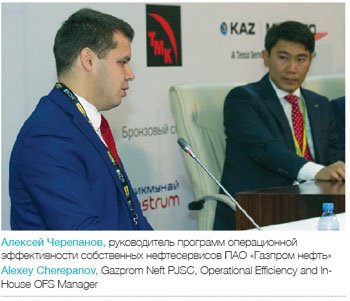
The 3rd and final presentatin before the networking sit-down lunch saw Serik Kaspayev, Deputy General Director for Operations at MH Industries look at the achievements, challenges and future developments at MH Industries looking at “Drilling companies at MH Industries – Achievements, Challenges and Future Developmentsl”.
Mr Kaspayev explained to the audience that – “LLP «MH Industry» is a holding company that consists of 3 drilling companies, including «Burgylau» LLP with 19 drilling rigs, whose main customers are Ozenmunaigaz, «KazMunayGas Bureniye», which has 11 drilling rigs of various classes, including light to heavy, all of which are mainly used at Embamunaigas fields. The third company is «Astra Star LLP», where are 4 rigs, which work mainly in Kyzylorda oblast for 2 contractors.” Followed by an interesting Q&A the morning sessions concluded and all the KDR participants were then invited to sit down together for lunch, which provided ample opportunities to continue the discussions in less formal surroundings.
Hall 1: Session 3
With lunch finished and all participants ready and fueled up for the afternoon discussions, Session 3 of Hall 1, welcomed Nuraly Guldzhumarov, JSC NC KazMunayGas EP Deputy Director of Drilling and Workover Department as the session moderator, with Ato Aidoo, Zhaikmunai LLP, Senior Drilling Engineer, Robert Wagner, MTU Friedrichshafen GmbH Senior Manager Mining, Oil and Gas Sales and Application Engineering EMEA and Kanat Ashimov, SRI PDT Chief Specialist of Drilling Technology Department, joining him as the session speakers.

Mr. Aidoo, Zhaikmunai LLP, titled his presentation «Rig inspection and non-productive rig time». And during his speech, he compared 4 rigs managed by locals and foreign companies based on the inspection results of 2011 and 2017. According to the technical evaluation of the equipment the drilling rigs under foreign management are significantly different from the drilling rigs managed by locals. Statistics showed that indicators of unproductive time on drilling rigs managed by locals are high. The presentation highlighted the main reason for the high indicator as the management style, the service culture, the lack of spare equipment and spare parts, and the lack of experience of the drilling crew when working with drilling equipment.
The presentation drew some excellent questions during the Q&A before Robert Wagner, MTU Friedrichshafen GmbH, delivered a case study, looking at «Heavy dry drilling in the Height of the Andes», with Kanat Ashimov, SRI PDT presenting on «Improving control cycle of the well from beginning to abandonment».

Mr. Ashimov, durign his presentation, outlined the problems of inadequacy and inaccuracy of the data for well construction design, the lack of feedback and a need for a consolidated approach to the formation of a single database and their solution.
Hall 1: Session 4
The last roundtable session, in what can only be described as an excellent day of discussions, saw Paul Seed, Director at TMG Worldwide as the session moderator, with Nurlan Zhumagulov, General Director of Association of Oil Service Companies of Kazakhstan making the sessions opening presentation, looking at the regional «Drilling market results, 2016»

Mr. Zhumagulov provided some very interesting statistics during his presentation, such as that by the end of 2016, the total purchase of oilfield services in Kazakhstan amounted to 2 trillion tenge, which is about 7 billion USD. 350 billion tenge were spent for drilling in 2016. He also pointed to drilling stats that in 2013, 1865 wells were drilled, but by the end of 2016, only 684 wells were drilled.
According to the presentation, the average value of success rate of exploration in Kazakhstan is 20-25%, and it turns out that the necessary amount of investment for the advanced growth of exploration is at least $1 billion.
The floor was then given to Maxim Sverchkov, Fixed Gas and Flame Detectors Business Development Manager, MSA Safety who delivered the final presentation of the day, looking at «Ultrasonic and Laser Gas Leak Detection Technologies of MSA Safety».
The final presentation wrapped up a very interesting day of in-depth discussions. The organisers received some excellent and constructive feedback from all the participants.

COMPLETIONS
Hall 2: Session 1
Hall 2 focused on Completions, which included participation from the region´s majors, with KMG E&P, SRI PDT, KPO and Zhaikmunai amongst the operators presenting.
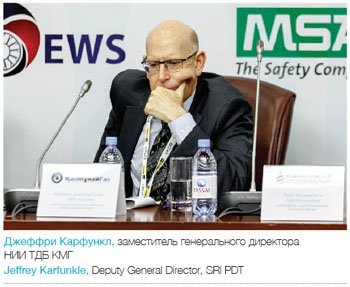
Jeffrey Karfunkle, Deputy General Director, SRI PDT, was the moderator for the first session, opening the talks by overviewing the planned discussions, before handing over to Temirbek Aldabergenov, Well Integrity Engineer KPO, who discussed «Rig-less mitigation of sustained casing pressure in Karachaganak oil wells by bleed-and-lube with high density cesium formate brine».
The presentation started by discussing the issues concerning tools, which provided the integrity of wells. He overviewed a short history of the company and work in the Karachaganak that started in 1984. They investigated problematic wells and pointed out the necessity to set up a well integrity workflow. Risks were assessed to find the resolution for ratification of the issues and he shared the plans to develop regulatory documents and procedures.
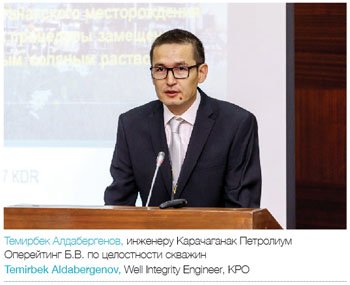
The presentation discussed the dangers and solutions to pressure control and concluded that the long term use of bleed-and-lube had achieved some good results.
Questions were raised by Askar Abishev from KMG SRI as well as Aybar Uandykov from Halliburton and Mustafa Arpaci from Zhaikmunai which ensured an informative Q&A session.
Then the floor was given to Maxim Buyanov, Completion Sales Manager from Schlumberger. He delivered a speech about Leak-Pass Isolation Technology of downhole equipment – expandable casing patch.
Mr. Buyanov, presented on casing patch technologies discussing its directions for use. The first, is maintaining well integrity, the second is a reconstruction of the well productivity. Coming to the topic, he explained that casing is expanded through the inflatable packer. Casing patches can be rotated whilst running in hole, but it is necessary to note that there is very high differential pressure.

The Q&A that followed saw many questions asked, with Rakhmetov Yerkin, Deputy Director of KMG SRI asking about external pressure and its role in choosing the tool. Questions from Artur Tleulin at the NCOC concluded the Q&A session.
The final presentation for this session, from the company TMK was broken in 2 parts, with Asylbek Bulekbayev, TMK, focusing his presentation on the «Use of sleeveless pipes in oil and gas projects in the Republic of Kazakhstan». Sharing TMK´s experience of hermetical casing liquidation in Kazakhstan, discussing the advantages and benefits.
In the following Q&A, questions were raised from Farit Agzamov from Ufa Oil University. He wanted to identify how they achieve cementing, with Mr. Bulekbayev explaining that compared to the tool presented previously they cement the space between the sleeve and casing.
The second part of the presentation was delivered by Evgeny Panarin, Lead specialist Premium Connections, concerning «Selection of tubing material for Ozenmunaigas».
With an interesting Q&A to follow – this concluded the session.
Hall 2: Session 2
With Hall 2 discussions well underway, Session 2 looked at liner technology with Berik Zhienbayev, SRI PDT, Drilling and Workover Technologies Department Director, taking over the moderating duties.

The floor was given to Rufat Mammadbayli, Well Engineering Manager, Zhaikmunai LLP, who started his presentation with a review of the Chinarevskoe field from 1996. The topic was “Liner cementing success in Chinarevskoe” and he discussed how the company plans to drill 7 wells this year and fracture number of them. In an excellent presentation, he also shared information concerning liner issues and clarified that cementing problems mostly come from a lack of centralization. «It might sound good on paper base but when it comes to the real situation lots of problems appear like the impossibility to rotate».
Some great questions were asked during the Q&A including on the preparation of the mud and comparing experiences in the field across Kazakhstan.

The second presentation for this session came from, Anton Ivanov, Business development director, NOV completion tools, reporting about «Transforming liner installation performance».
He presented their new tools and solutions, which measures internal and external pressure, as well as the temperature after running in. He followed on from Mr. Mammadbayli, highlighting how the tool helps to get information on pressure during rotation, which is important to complete an effective cementing process.
Q&A questions coming from Mr. Mammadbayli and session moderator, Mr. Zhienbayev concluded the presentation before the floor was passed to Azamat Taitarazov, Service coordinator, Halliburton.

After expressing gratitude to all KDR participants and emphasizing the value of the event he focused his presentation on «Completion and Engineering Solution for oil and gas projects in Kazakhstan».
He started by focusing on the regional challenges faced in the fields of Kazakhstan, such as deep water, unconventional plays, mature fields, high temperature wells and pressure.
Mr. Taitarazov discussed the companies’ solutions to these challenges, outline technologies including intelligent and multistage fracture completions. He also presented to KDR participants, Versaflex, which is expandable liner hanger.
“It doesn’t have moving parts and outside ports like conventional liners. You just run the ball to TD and drop the ball then set hanger after the cementing job.”
With the presentation complete and lively discussions during all the morning sessions – the hall broke and participants moved to the lunch hall for a welcomed meal.

Hall 2: Session 3
After a hearty lunch, participants, roundtable members and event sponsors, gathered for the afternoon sessions, moderated by Rustam Aldangorov, KMG EP Lead Engineer.
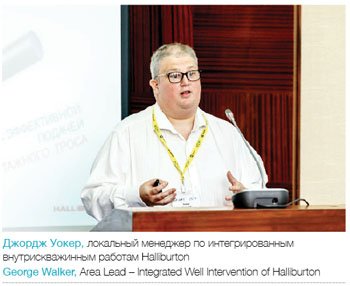
The first presentation of the afternoon focused on “Immediate impact solution» and was delivered by George Walker, Area Lead – Integrated Well Intervention of Halliburton.
He first clarified that when discussing “immediate solutions” they mean immediate intervention and quick actions using real-time technology to reduce production issues or losses from unforeseen production declines.
He discussed that Halliburton has identified a number of challenges that regularly arise, as more and more production comes from the mature fields. When it comes to solving fields problems, Halliburton experts and specialists, work with local specialists from the customer who have all the detailed information about the field and well, in order to increase the chances of production optimization.
After discussing Halliburton´s case studies across the globe, the Q&A session focused on the results after implementation how these services could deliver similar success in Kazakhstan.

The final presentation for the day in Hall 2 was delivered expertly by Assol Kubeisinova, KPO Senior Well Services Engineer, with a focus on Balls and Baffles Milling Using Downhole Tractor.
Ms. Kubeisinova, started with an introduction to the Karachaganak oil and gas field. She shared best practices in the field with detailed, stage by stage explenation. “Once the well is completed, before stimulation, we drop the ball, pump it down, the ball sits on a baffle, making it possible to open sliding sleeve.” After some extensive explanations on how they optimized the milling of the baffle, she introduced the tractor milling operations. The tractor is activated via cable and usually, it is used in highly deviated horizontal sections of well.
The presentation drew a good response from the participants, who asked and probed with many questions during the Q&A. Questions from Ermekov Mulat and Akimzhan Lukpanov from KazgerMunai, were followed by questions from Maxim Buyanov, Schlumberger, and Azamat Taitarazov.
Hall 2 produced some excellent conversations, highlighted best practices and allowed knowledge sharing between the major companies operating and working in the region.
With the Hall discussions finished, the participants gathered in the lobby area, to network, enjoy some post-show food and drinks and listen to some great local entertainment laid on by event organizer TMG Worldwide.
WELL INTERVENTIONS
Hall 3: Session 1

With up to 1000 wells being outlined as potentials for interventions and workovers – Hall 3 discussions were to focus on fracturing, sidetracking and enhanced oil recovery.
David Szabo, 1st Deputy General Director of KMG´s SRI PDT, started the morning proceedings as the event moderator, introducing Mikhail Dviborodchin – Project Manager, Drilling and Downhole Operations, Gazprom Neft STC – with a case study “30 Multi Stage Frac Job, Priobskoe Oilfield”.
He discussed GPN technological challenge on the increase of the drainage zone, and performing increased fracturing whilst reducing costs. For this he explained, GPN developed and implemented a program called Optimized Design, which established the KPI of the project and the project team. The main purpose of the project was the implementation of 30 large (more than 40tn proppant per stage) trouble-free fracture stimulation operations with minimum time and costs expenditures.

The presentation was extremely interesting to the audience and the following Q&A encouraged some great discussion from the roundtable members as well as the general KDR audience.
Next to take the floor was Alexey Bairamov, Director for Business Development at EWS, with a case study looking at “Using Mongoose SFC (Shift/Frac/Close) for Well Control and Re-Fracturing in Sour Gas Environments”.
He continued on from the previous presentation, looking at how to select the optimal technology for well completion, with the ability to test each well after stimulation and ultimately have more control of the production process. In addition, he explained they wanted the option to perform re-fracs, without adding significant costs.
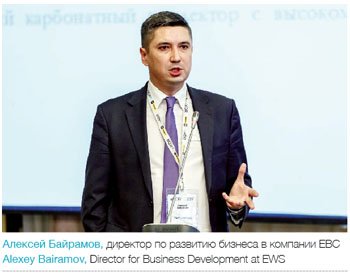
The candidate well was a cased open hole, deep and horizontal with a highly deviated wellbore. Mr. Bairamov discussed in depth, the challenges including high H2S found within the formation fluids and solutions employed.
A great presentation drew an in-depth Q&A before Yerniyaz Balgozhenov, Stimulation Engineer, Schlumberger was introduced to make a presentation looking at Retarded Acid and New Degradable Diversion Techniques for Production Enhancement.
The presentation focused on Schlumbergers “OpenPath Reach Technology” outlining the key steps for a successful acid frac, focusing on issues such as Pump Rate, Bottomhole Temperatures, Acid Concentration and Acid Volume. He then continued to highlight the process in a case study, performed in Kazakhstan late 2016 – highlighting the success of OpenPath Reach Technology and its benefits.
An excellent presentation concluded the first session of the morning and all participants broke for the morning “Networking” coffee break – where discussions continued over a hot drink and pastries.

Hall 3: Session 2
The second session started were the last session left off – with Dave Szabo continuing the moderation, with this session looking at Fracturing and Enhanced Oil Recovery solutions.

First to take to the floor was Yerlan Makeyev, General Director, MunaiFieldService LLP, to present on their New Fleet for Hydraulic Fracturing.
Mr. Makeyev went on to discuss their fleet and the best practises for conducting operations including; the creation of models, lab testing, the correct equipment configuration, forecasting, implementation then post project review and analysis and database creation. He went on to discuss the benefits of on site lab testing and the need for control and measurement of real time fluid samples. After some case study analysis
A fantastic opening presentation in this session drew some good questions from all participants, before the floor was pasted onto Christian Goy, Manager Sales Mining & O&G, MTU Friedrichshafen GmbH.
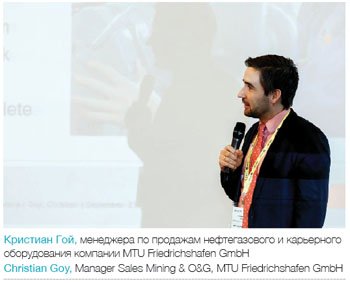
Mr. Goy´s presentation focussed “Fracking in Extreme Conditions: Braving Siberia’s Cold” – and immediately stimulated an active discussion between manufacturers and end users regarding engine run-life.
As the discussion became ever more technical, Robert Wagner, Senior Manger Sales Mining Oil and Gas, MTU, commented on the statistics and outlined the parameters of the discussed run-life.
With the participants truly “warmed-up” the floor was past to Song Yuanfei, Engineer from Engineering Technology Research Institute at Sino Kazakhstan Great Wall Drilling Company LLP, who delivered an excellent presentation on the “Use of Nitrogen Injection to Increase Oil Production”.
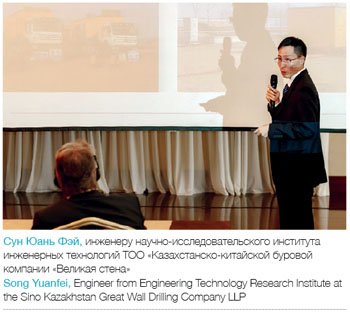
After introducing the concept and technologies involved, he went on to describe successful implementation of this technology, using case studies from around the world – including a milestone for EOR solutions in Sudan, in the Jake South Field, that saw production climb to over 30,000 BOPD from 9,000 BOPD, including peak well production of 15,272 BOPD. He continued to highlight impressive results from case studies and wrapped up a great presentation with a proposal for the regional K Oil Field.
With Mr. Yuanfei´s presentation and Q&A complete – all participants were invited for a sit lunch “Networking Luncheon” and well deserved refreshments.
Hall 3: Session 3
Moderating the afternoon sessions in Hall 3 was Jeffrey Karfunkle, KMG SRI PDT, and the floor was passed directly to KMG to present on Well life cycle control improvement from drilling to abandonment.
The presentation discussed some fo the common problems within well design and the needs for a centralised software system to unify all the stages of a well’s construction. That the soaftware must produce rapid solutions for factors including; wll path, geometry, BHA’s, formation pressure gradient. The case study continued to discuss the reporting aspects from all the relevant JV’s and daughter companies and the benefits the system has brought to KMG.

The presentation drew an in-depth Q&A session and once complete, Yeleu Tilekkabyl Amanzholuly, Deputy General Director – Drilling Service, Zhigermunaiservice LLP finished the session, with a case study, titled: Sidetracking Using Casing Exits at Uzen and Karamandybas Fields
After discussing the potential services that ZMS offers and their skills and case histroies in cutting side track windows Mr Amanzholuly discussed some of the challenges in tackling regional projects. One of the key areas for concern included the difference between the technical project and the terms of reference, since there is often a discrepancy between the basic requirements and the primary information in these documents. It was essential to construct the well around the latest log and sample data. He finished by discussing the well construction equipment requirements and how careful section is essential to having a successful project.
Hall 3: Session 4
Continuing the moderation of the fourth session in the third hall, Jeff Karfunkle, passed the floor to Lyu Wengi, Director, Technology Development Center, Sino Kazakhstan Great Wall Drilling Company LLP: «Engineering approaches to enhance oil recovery».
Mr. Wengi started with talking about major factors affecting carbonate reservoir production at late-stage development. Then he came up with the classification of residual oil in carbonate rock. Lyu Wengi pointed out that the effective fracture study is crucial to oil production due to a large distribution of fracture-porosity type reservoir in Kazakhstan. Further, he presented five engineering approaches such as radial drilling, multilateral drilling, sidetrack drilling, workover by SET, MECT. He continued by highlighted filed case studies and to conclude, he pointed out two things: 1) in oil-gas well operation, due to severe formation depletion, the liquid level inside wellbore is far away from hole mouth, this causes downhole work failure and fluid loss. Compound micro expensive cement technology can be applied to this situation. 2) In middle and late periods of operation, due to the anisotropy of formation, water layers press onward, causes water flood, therefore exploration cannot be achieved.
During the Q&A, Kozhakhmetov Mirat from Schlumberger asked how they oriented to control radial drilling, further questions probing the use of acids which concluded an excellent presentation.
The second presentation was delivered by Vladimir Evstegneev, Petro Welt Technologies Operation manager about Side Tracking – Progress and Development.

Mr. Evstegneev, introduced the PeWeTe group of companies and clarified that there are three companies, which works on fracturing, cementing of liners, the second company is specialized on sidetracking only, the third is drilling company. He highlighted the fact that the company completed more than 35000 fracturing works in Kazakhstan and Russia since 2005 with over 1500 side-tracks completed within the last 12 years.
The presentation was then continued by Rinat Vagizov, drilling director of KATOBneft. He presented multistage hydraulic fracturing and technologies which helped to increase the production of heavy oil. They set up additional packers, elements to keep cementing absorption.
During question and answer session details of installation were identified. Berik Zhienbayev, SRI PDT Department Director, drilling and workover technologies, probed into the difference of pipping used.
This final presentation wrapped up a very interesting day of discussing for Hall 3 and all participants were kindly asked to join all KDR participants to enjoy the “Networking” cocktail reception.

